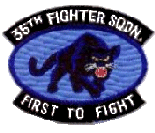David Johnson Remembers Ejecting from His Stricken F-4
On September 8, 1972 at MacDill Air Force Base, Florida, I was part of a six F-4 Phantom mission that briefed at 0-dark-30 for a 4 vs. 2 similar Air Combat Maneuvering (ACM) flight in the restricted area Southwest of St. Petersburg, Florida. All aircraft were configured “slick” no tanks, no ordinance.
Capt. Paul Poppe was the overall mission commander and the aircraft commander of Where 01. I, 1st Lt. David Johnson, was assigned as the student WSO in Where 01 in F-4E 66-310.
Upon takeoff, Paul and I noticed uncommanded pitch oscillation and we went through the emergency procedure and both agreed that the most likely cause was runaway stabilator trim. We followed the emergency proeedures, pulled the stabilator trim circuit breaker and engaged the autopilot. We joined up with the other five aircraft, aborted the mission and arranged for an escort back to MacDill. The instructor pilot in the lead of the two ship formation was Major Al Winkelman. Winkelman’s F-4E with a student pilot in the front seat had a PC-1 failure in their aircraft so we chose to escort each other home. Major Winkelman suggested to us that we should think about getting out of the aircraft.
Descending through 5,000 feet, in accordance with the Emergency Procedures in the checklist, Paul and I initiated a controllability check, to see if the aircraft would be controllable in a landing configuration. I was calling out the checklist items and Paul would then execute the procedure. That’s when our day went from bad to worse.
The first item on the checklist was to disengage the autopilot. As soon as Paul disconnected, the aircraft pitched 90° down and began to accelerate, even with the throttles in idle. Paul said the stick would not move fore and aft and asked me to pull as well. With both of us pulling, and our feet on the dashes we could not pull hard enough to move the stick.
At that point I told Paul adios and I pulled that wonderful Martin-Baker ejection handle between my legs. The ejection initiated perfectly, I had a horizontal ejection over Sarasota Bay and when I regained my eyesight I checked my canopy and looked for Paul.
Paul ejected several seconds later and was in the water near the South end of Longboat Key off Sarasota. I think he had one swing in his parachute before hitting the water.
I feel that I ejected somewhere between 3500 and 3000 feet and could see as I descended that Longboat Key was a mass of Mangroves and I steer my parachute toward the only clearing I could see. I landed safely, grabbed my survival radio and smoke flares and used my helmet as a basket and headed East toward the water.
I was picked up the U.S. Coast Guard. Paul was picked up by a MacDill rescue helicopter, and flown to the MacDill base hospital. The conclusion of the accident board, after 30 days of dredging for parts, was that the pitch control linkage had become disconnected, that part was found on the last day of dredging and there was no joining pin.
God Bless Martin-Baker for my last 45 years!!
See Richard Keyt’s article called “Thank You Martin Baker.”

